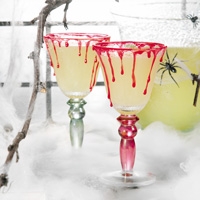Barry Ancelet, Cajun historian and head of the University of Louisiana at Lafayette Folklore Department has explained the origin of the Courir as being in rural Medieval France:
People escape from ordinary life through the alcohol and the roles they portray in costume. In the early morning the riders or runners or Mardi Gras (as the troop and its individual members are known) gather in a central meeting place. As they gather, Le Capitaine (the leader of the Mardi Gras) and his co-capitaines explain the rules and traditions that must be followed. The Capitaine usually rides on horseback, wears a cape and carries a small flag. After he organizes the troop, the bands begin to play and he leads them on the route. Traditions vary in each town with the way it is carried out. Some towns have people on horse back, some on trailers and some on foot, and others use a variation of all three methods. The Capitaine is the first to approach the houses along the route, to ask permission to enter onto their property. At this point, in the spirit of frivolity, individual Mardi Gras will attempt to sneak onto the property. They are held in check by the Capitaines, who sometimes brandish a plaited burlap whip.
The whips are designed to be flexible and not to inflict any serious damage onto their victims, but do produce a loud noise for the edification of onlookers. Participants claim one has not fully participated until one has been whipped. Once they are on the property, the revelers play a variety of pranks on the farmers and beg for food for the communal gumbo that lies at the end of the route. A prize ingredient is a live chicken, which is usually thrown into the air for the drunken Mardi Gras to chase through the muddy yards and fields.
A traditional tune is sung by the participants, although the exact lyrics vary greatly from town to town. The melody of the traditional folk song is similar to melodies of the Bretons on the northern coast of France. This version is sung at the Church Point Courir de Mardi Gras:
Les Mardi Gras vient de tout partout, tout le tour du moyeu. Vient une par an pour demander la charité. Une vieille patate, une patate et des gratons.
Capitaine, capitaine voyage ton flag, tout le tour du moyeu. Une fois par an pour demander la charité. Et des patates, des patates et des gratons.
Les Mardi Gras vient de l'Angleterre, tout le tour du moyeu. Vient une fois par an pour demander la charité. Une vieille patate, une patate et des gratons. The Mardi Gras come from everywhere around the hub. Once each year to ask for charity. An old potato, a potato and some cracklins. The Mardi Gras come from England, all around the hub. Once each year to ask for charity. And potatoes, potatoes and cracklins.
People escape from ordinary life through the alcohol and the roles they portray in costume. In the early morning the riders or runners or Mardi Gras (as the troop and its individual members are known) gather in a central meeting place. As they gather, Le Capitaine (the leader of the Mardi Gras) and his co-capitaines explain the rules and traditions that must be followed. The Capitaine usually rides on horseback, wears a cape and carries a small flag. After he organizes the troop, the bands begin to play and he leads them on the route. Traditions vary in each town with the way it is carried out. Some towns have people on horse back, some on trailers and some on foot, and others use a variation of all three methods. The Capitaine is the first to approach the houses along the route, to ask permission to enter onto their property. At this point, in the spirit of frivolity, individual Mardi Gras will attempt to sneak onto the property. They are held in check by the Capitaines, who sometimes brandish a plaited burlap whip.
The whips are designed to be flexible and not to inflict any serious damage onto their victims, but do produce a loud noise for the edification of onlookers. Participants claim one has not fully participated until one has been whipped. Once they are on the property, the revelers play a variety of pranks on the farmers and beg for food for the communal gumbo that lies at the end of the route. A prize ingredient is a live chicken, which is usually thrown into the air for the drunken Mardi Gras to chase through the muddy yards and fields.
 Halloween alcoholic drinks |  Halloween Punch Recipes |  Halloween Drink Recipes |  This Halloween party punch |  I started researching drinks |
 Best Halloween Mixed Drink |  alcohol Halloween drinks |  halloween alcoholic drinks |  alcohol Halloween drinks | Non Alcoholic Halloween Drinks |
Capitaine, capitaine voyage ton flag, tout le tour du moyeu. Une fois par an pour demander la charité. Et des patates, des patates et des gratons.
 alcohol Halloween drinks |  5 Yummy Halloween Cocktails! |  easy and adult Halloween |  Funnel : Halloween alcohol |  Halloween Punch (alcohol-free) |
 Photo: Dragon\x26#39;s Blood Punch |  Non Alcoholic Halloween Drinks |  More Fun Halloween Drinks |  Halloween Hooch » Curbly | DIY |  sign signs halloween drink |



No comments:
Post a Comment